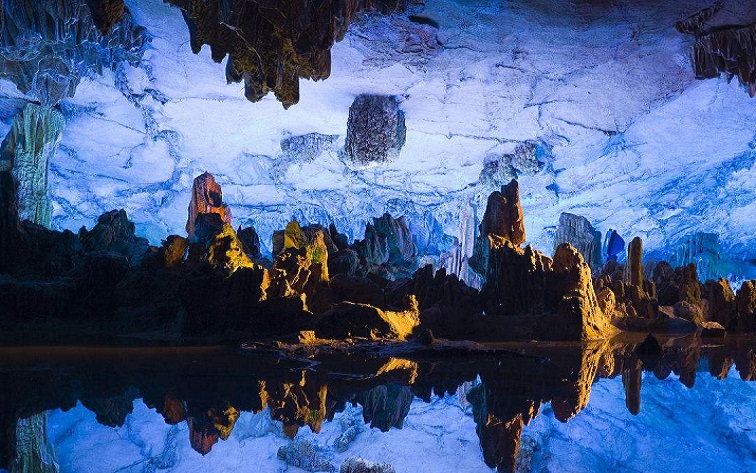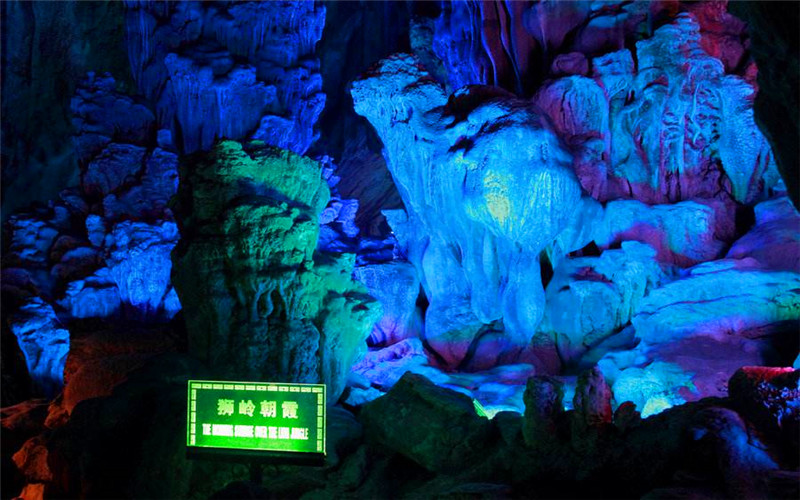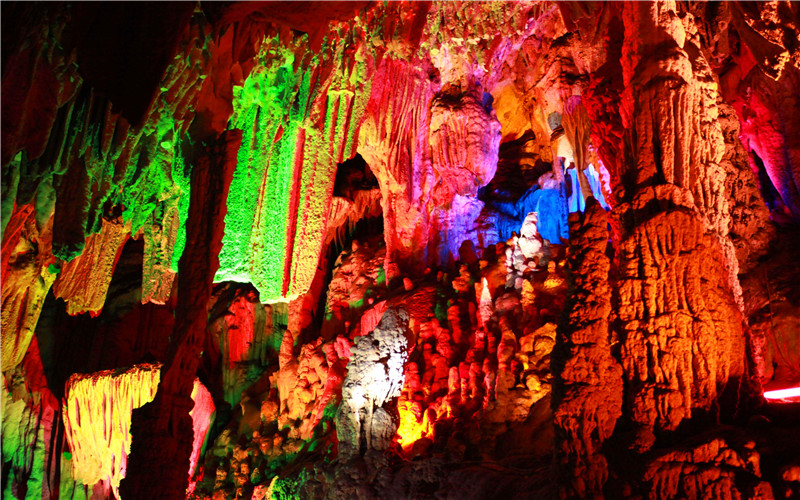Reed Flute Cave Overview
Walking into Reed Flute Cave, people are amzazed at a wonderland. The underground river peacefully flows along the cave, with the reflection of the cave veiling on the river and flowing quietly with the stream, which makes the beauty even more vivid and dynamic. The interior of Reed Flute Cave is a sight that can not be recreated anywhere else on earth and these distinctive formations have names that match their appearance, and some are said to resemble mythological creatures or modern structures like the Statue of Liberty. Out of the cave, the abundant reeds grow and thrive. Locals once used the reeds to make flutes, hence people call the cave here the Reed Flute Cave.
Despite the nature-made artworks, there are 77 ink inscriptions of poems and travelogues inside the cave, which shows that the Reed Flute Cave has already became a popular scenic spot since ancient times, the oldest inscription can be dated back to the Tang Dynasty about 1,200 years ago. However, it is widely believed that the cave was well preserved and untouched for a thousand years before it was rediscovered in 1940's by a group of fleeting Japanese refugees in China's anti-japanese war period. The cave was opened to the public in 1962 and from then on it has become a popular attraction. some great leaders of China and foreign countries once visited the Reed Flute Cave, among whom are the former Chinese leader Deng Xiaoping, former US presidents Nixon and Carter, and former UN Secretary-General De Quillar.
Famous Stalactites and Stalagmites to See in Reed Flute Cave
The stalactites, stone pillars and rock formations in the Reed Flute Cave were created by carbonate deposition over millions and millions of years, many of the formations are vividly imitated as landscape, animals and other creatures. For example, there is a figure-like formation which looks very similar to the Statue of Liberty. Some of the rocks have been given very romantic and poetic names.
Lion Rock and Sunrise
The various stalactites are fully used for nature's metaphor: tall peaks, dense forests, and gigantic tree trunks. Every time the sun rises, there are groups of "lions" dancing heartily in the forest in front of the rising sun, making the whole forest full of vigor and vitality. Here is a big "lion" among them. It is watching over a group of little "lions" playing on the side of the mountain.
Crystal Palace
It is the widest place of Reed Flute Cave, 93 meters (305ft) wide and 18 meters (59ft) high. A huge "Crystal Palace lamp" hangs on the upper left of the hall. It paints the hall with a magical color, like the Dragon King's Crystal Palace in the Chinese myth. Walking into this hall, it is very flat, empty, and not crowded with stalactites. The flat surface, and the top rock is relatively complete, with less fissures.
Pines in the Snow
It consists of two unique stalagmites. One is like a snowman. The other is like a pine tree with thick layers of snow on its branches and leaves, standing in the forest. As a Chinese saying goes, "Pines turn greener after snow", and the snowy pine tree shows its tough and hardy characters which Chinese people always admire. The "snow" here is made up of calcite crystals.
Sky-Scraping Twin
You will enjoy the magnificent panorama of a "primeval forest": there are hundreds of "pines", "evergreen cypresses". Many of these dense pillars form the most spectacular stone forest . The twin pillars in the forest are truly lofty, thick. when you have a close-up, they reveal the differences. Both of the pillars seem very tall and straight up to the sky, so people call them " Sky-Scraping Twin".
Ancient Inscriptions
There are altogether 77 inscriptions, including five in the Tang Dynasty (618AD-907AD), eleven in the Song Dynasty (960AD-1279AD), one in the Yuan Dynasty (1271AD-1368AD), four in the Ming Dynasty (1368AD-1644AD). There are many inscriptions of poems and travelogues written by scholars, monks and tourists. You can enjoy the ancient calligraphy in different period of China. These writers came from all over the country, indicating that Reed flute cave has been a tourist attraction with a long history. The oldest inscription in Reed Flute Cave can be dated back as far as the 6th year of Zhenyuan in the Tang Dynasty (790 AD). Some inscriptions are also evidence showing the monks have visited together, reflecting the prevalence of Buddhism in Guilin. Nowadays, they also became useful materials for studying the spread of Buddhism in the Tang Dynasty.





